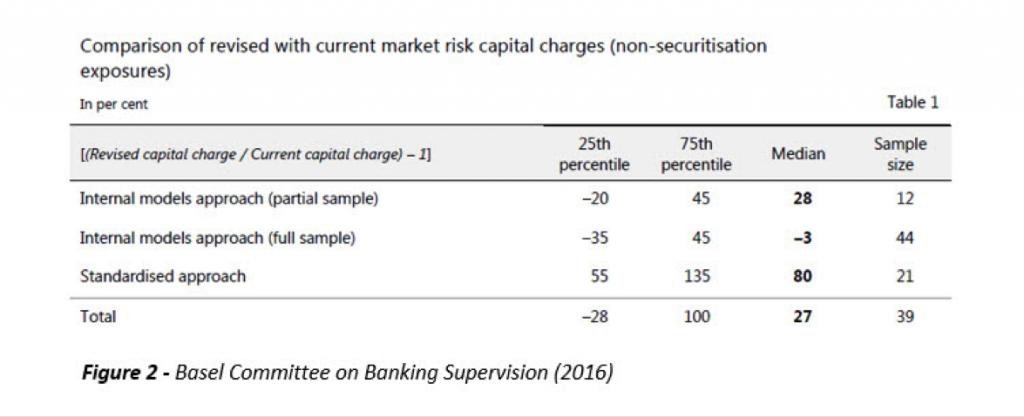Fundamental Review of the Trading Book: impact on capital requirements and risk architecture
The introduction of the Fundamental Review of the Trading Book (FRTB) requires a rethink when it comes to risk architecture and data requirements. Xavier Dubois, Wolters Kluwer’s senior risk and finance specialist for EMEA, outlines the key points.
There is an area of complete agreement when it comes to examining the potential impact of FRTB – the new market risk regime will undoubtedly have a huge impact on capital and banks will find a huge capital jump in their impact analysis. Based on a Wolters Kluwer sample of 44 banks the new standard will result in a weighted average increase of 40% in total market risk capital charges. From a total Basel III capital requirements perspective, the new regime will lead to a 4.7% weighted mean increase. This increase is reduced compared to the consultation paper proposals. It also does not take into account the adaptive reaction from banks to the new regime. Experience shows that bank will adapt their behavior to reduce the capital charge increase. Nevertheless it’s fair to say that the new market risk standard will require banks to hold more capital, but there are clearly winners and losers here.
For non-securitisation exposures (72% of market risk exposure in the sample data) the increase in capital is significantly higher in the standardised approach than in the internal model approach. For the standardised approach, the median increase is 80% and the 25th percentile has a 55% increase. This is consistent with the general objective of increase of capital requirements for market risk. Under the internal approach, while there is a slight decrease on the full sample for the median, -3%, on the sample with high quality data – i.e. where the impact is better measured – the median increases by 28%.
It is worth noticing that still on this high quality data sample some banks using internal model will have good news: the 25th percentile shows a decrease of market risk capital requirements by 20%. Ultimately, data sample show a median increase of 27% market risk capital requirements for non-securitization exposures, higher under the standardised approach compared to the internal model approach, and with more than a 25% of winners under the internal model approach (see Figure 2 below).
For securitisation exposures (28% of market risk exposure in the sample data), when excluding the correlation trading portfolio, the new standard gives a 22% median increase. On the correlation trading portfolio, the increase is 70%.
Analysing the capital requirements between the two approaches (for non-securitisation exposures), the median is about 40% higher in the internal model compared to the standardized approach. Detailing per risk component, the additional capital ranges from about 20% (for credit spread risk: non-securitizations and foreign exchange risk) to about 50% for equity risk. It is worth noticing that the highest standard deviations are with interest rate risk and, foreign exchange risk – the latter being applicable to bank with only a banking book as well.
The two trading desk tests for eligibility of internal market models
If firms need to run tests to determine whether a trading desk can use an internal risk model they will have to pass two tests at the individual desk level. In the consultation papers which were released prior to the final iteration of the rules, there was a third requirement: a model-independent risk assessment tool per desk. While the fundamental idea of a risk-independent assessment is kept with the independent risk control unit, the Basel committee did not want to go as far as imposing additional systems and have therefore dropped the third requirement in the final standard. The two tests that remain for determining the eligibility of trading activities are:
Test 1 – P&L attribution
This involves comparing ex-post P&L forecasts by risk models that are actually observed, to check that the model incorporates all relevant risk and factors. Conceptually from the industry, this has received positive feedback and it’s acknowledged that P&L attribution is a useful tool, although there are some serious concerns about how practical it will be to apply a strict statistical test on this, so it’s more the statistical test section of being questioned rather than the P&L attribution process.
In these tests, risks that are new to P&L need to be compared to the actual daily desk level P&L to determine whether the risk factors included in the desk risk management model capture the material drivers of the banks actual P&L. You see here two metrics, so the P&L attribution requirements will be based upon two statistical metrics. The first one looks at the mean of the difference between the theoretical and the actual P&L and is then divided by the standard deviation of the actual P&L. The second test is the variance of the unexplained P&L divided by the variance of the actual P&L. So these are the tests that firms need to pass. Overall, the industry welcomes this approach, but there’s some outstanding questions on how to implement it and about the statistical tests in particular.
Test 2 – Back testing
The performance of a trading desk group management model needs to be evaluated through daily back testing. These tests need to be run at each trading desk as well as on a global level. As back testing is already well established it is no surprise to find this in the new market risk standard. One critique is that there’s a large discrepancy between the driver of capital and capital as defined by stress liquidity adjusted expected shortfall, whereas back testing occurs on Value-at-Risk. However, this offers some advantages in capturing fat tail in the distribution of asset returns. There is no clear academic or supervisory guidance on how expected shortfall can be practiced in a statistically meaningful way, so a drawback with back test and Value-at-Risk is the separation of the measure in determining the capital, following the back test it has measured.
Time to re-think banks’ risk architecture
Limits between the trading and banking book have been revised, so it is important to correctly allocate positions to these new trading and banking book definitions – failure of doing this will lead to incorrect and increased capital buffers. It is also important to ensure consistency, among others with the accounting classification (e.g. IFRS 9), which is explicitly required. The new regime imposes quite stricter standards and deviations require justification.
New risk and capital calculations are introduced by the new market risk standard, including risk sensitive standardized approach and expected shortfall calculations in internal models. Both approaches are complex and computationally burdensome. Additionally banks using internal approaches must now compute the standardized approach as well. Also banks will need to comply with the new regulatory reporting templates – which as yet have not been made available – and fulfill new disclosure requirements that will be in a separate publication.
From a business point of view, there will be an impact overall, as it will add constraints, and risk appetites will need to be reviewed accordingly. Redefinition of hedging and diversification strategy needs to be done sooner rather than later to avoid big increases in capital requirements. In case you do not stop doing these activities then you have to have a clearer strategy on how to manage the additional capital buffers.
And more is to come: the new Interest Rate Risk in the Banking Book (IRRBB) will be introduced shortly after the market risk changes. The IRRBB will also have an impact on banking book positions and the capital that is held for that.
Overall, considering all these aspects, the new market risk standard will certainly require banks to re-think their risk architecture, so inevitably operational burden and costs will increase. As already stated, this will lead to an increase in capital requirements. It is important for banks to understand this impact now and set up the right hedging and diversification strategies.
This article is a follow-on from an earlier comment piece by Xavier Dubois: FRTB – who is affected?













































